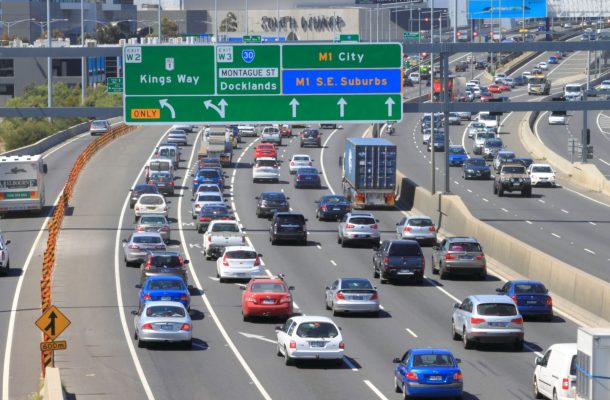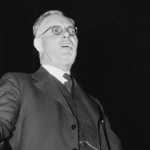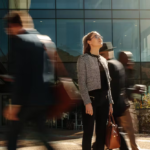Building more roads will not solve Melbourne’s transport crisis

According to government forecasts, Melbourne’s population will be about eight million by 2050, the same as London’s population today. But where London has more than 1000 trains on its metropolitan network, Melbourne has only 200; and while 8000 buses travel through London streets, only 2000 operate in Melbourne.
If Melbourne is to match London’s level of transport efficiency by 2050, we have to grow our public transport network by “300 to 400 per cent”, says Monash’s Professor Graham Currie.
Building more roads won’t solve our transport crisis, he says, even though Melbourne’s outer suburbs are the fastest-growing in the nation. Melbourne has the lowest car occupancy rate in Australia during peak hour (1.06 people), and that’s because 1.4 million of us lack access to quality public transport.
Transport infrastructure is a hot issue in the Victorian election on 24 November, but the challenge is too important to be handled by state government politicians alone, Professor Currie says. Ideally, it should be removed from the political arena. Unfortunately, this is not the Australian way.
“We don’t have proper planning in Australia,” Professor Currie says. “We have a series of statements designed to capture media attention.”
Partisanship is unhelpful
The public transport plans put forward by Labor and the Coalition this election year don’t lack merit, he says, but the partisan approach is unproductive and can be confusing.
The competing statements about a rail line to Monash are a good example of the current state of dysfunction. So far this year, a light rail from Caulfield to the Clayton campus was announced by the state Labor government in April, followed by a federal Coalition government commitment in the May budget to provide funds for a heavy rail line to Monash from Huntingdale station.
Then, in August, state Labor announced a $50 billion plan for a 90-kilometre suburban rail loop linking Monash, Deakin and LaTrobe universities and the airport. The loop would run underground between Cheltenham and Broadmeadows and would end at Werribee. It would include 12 new stations, would connect to all the suburban train lines and include new regional interchanges for country travellers. Work on the first stage – between Cheltenham and Box Hill – would begin in 2022.
Professor Currie says he loves the plan because it’s ambitious – and the city needs big-scale, visionary planning if our public transport challenges are to be met. At the same time, he deplores that the loop was announced “out of the blue”.
“Historically, Melbourne has always followed a path of building new roads to solve traffic congestion problems. But in the medium to long-term they don’t solve the problem. In London they’re not building new roads, they’re building new rail lines.”
The plan has been described as the biggest public transport project in Australian history, but where is the consultation with the public, with public transport engineers, urban planners, land-use experts and local government communities?
“It is a really good project,” he says, but he’s concerned that it could be derailed without bipartisan support.
Meanwhile, the Coalition has proposed a $19 billion plan to build a faster regional train network, including express 32-minute trains between Melbourne and Geelong.
European-style fast trains to the regions are a “great idea”, Professor Currie says, but he fears that the cost of upgrading the tracks to accommodate faster trains has been underestimated (as it was when the Bracks government built its so-called fast train network).

A fast train to Traralgon, for instance, would require building new elevated tracks on the recently completed sky rail sections of the Dandenong line – another example of why coordinated, non-partisan transport planning is a good idea, Professor Currie says.
The Labor proposal to separate the regional and metropolitan tracks in the inner west would also have to be incorporated for the scheme to work.
He supports the Labor proposal to remove a further 25 level crossings, but points out that once this work is done, more than 100 additional level crossings will remain on the network.
“They have got to keep going,” he says.
The Melbourne east-west Link
Professor Currie doesn’t back the Coalition’s proposal to revive the east-west road link.
“Historically, Melbourne has always followed a path of building new roads to solve traffic congestion problems,” he says. “But in the medium to long-term they don’t solve the problem. In London they’re not building new roads, they’re building new rail lines.”
Two outstanding public transport issues have so far not been raised by either party in the state election campaign, he says.
One is the 1.4 million people in outer Melbourne who don’t have access to regular public transport, and would benefit greatly from more frequent bus services.
The other is the inefficiency of our tram network. We have the largest streetcar network in the world – more than twice the size of Toronto, which is the second-biggest – but it’s also one of the slowest in the world.
The reason is because our trams are held up by traffic. He’s confident that common sense will eventually prevail, and that trams will be allowed to move through the streets more efficiently.
In the meantime, people jump into their cars because the trams are too slow. And the trams are slow because of the number of cars on the road.
This article was published by Lens at Monash University.
Open Forum is a policy discussion website produced by Global Access Partners – Australia’s Institute for Active Policy. We welcome contributions and invite you to submit a blog to the editor and follow us on Twitter, Facebook, Linkedin and Mastadon.













